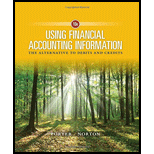
Concept explainers
Transaction Analysis and Financial Statements
Beachway Enterprises was organized on June 1 by two college students who recognized an opportunity to make money while spending their days at a beach in Florida. The two entrepreneurs plan to rent beach umbrellas. The following transactions occurred during the first month of operations:
June 1: Received contributions of $2,000 from each of the two principal owners of the new business in exchange for shares of stock.
June 1: Purchased 25 beach umbrellas for $250 each on account. The company has 30 days to pay for the beach umbrellas.
June 5: Registered as a vendor with the city and paid the $35 monthly fee.
June 10: Purchased $50 in miscellaneous supplies on an open account. The company has 30 days to pay for the supplies.
June 15: Paid $70 bill from a local radio station for advertising for the last two weeks of June.
June 17: Customers rented beach umbrellas for cash of $1,000.
June 24: Billed a local hotel $2,000 for beach umbrellas provided for use during a convention being held at the hotel. The hotel is to pay one-half of the bill in five days and the rest within 30 days.
June 29: Received 50% of the amount billed to the hotel.
June 30: Customers rented beach umbrellas for cash of $1,500.
June 30: Paid wages of $90 to a friend who helped over the weekend.
June 30: Paid the balance due on the beach umbrellas.
Required
Prepare a classified
Want to see the full answer?
Check out a sample textbook solution
Chapter 3 Solutions
Using Financial Accounting Information
 Financial Accounting: The Impact on Decision Make...AccountingISBN:9781305654174Author:Gary A. Porter, Curtis L. NortonPublisher:Cengage Learning
Financial Accounting: The Impact on Decision Make...AccountingISBN:9781305654174Author:Gary A. Porter, Curtis L. NortonPublisher:Cengage Learning
